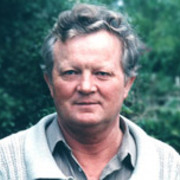
Bob Stenhouse
Bob Stenhouse was born and raised in Dunedin. His childhood involved many Disney and Beano comics, and repeated borrowings of Walt Disney book The Art of Animation from the library. That interest in animation grew while at Canterbury University’s Ilam School of Fine Arts. In 1968 he won an international award judged by legendary British-based animator John Halas; Stenhouse’s short The Equality of Man illustrated one aspect of the United Nations Declaration of Human Rights.
Freshly-graduated, he joined Wellington regional station WNTV-1 the same year. Over his next 12 years at the state broadcaster, his talents were used whenever graphics were required on-screen, whether it be for a show's opening titles, or a short graphics sequence on a current affairs programme (including Gallery, and the sequence near the start of this Inquiry documentary). He also worked on occasional commercials, and in the early days, ‘programme summaries’ — illustrated slide shows of the evening’s viewing schedules, which aired directly after the primetime news.
In 1980 Stenhouse joined Government filmmakers the National Film Unit. The NFU design department were continuing to create graphics and animation for NFU films, but in-house animators Larry Nelson (Parallel Line) and Nicki Dennis (Māori Legends of New Zealand) were also given time to create animated projects, similar to those made by the Canadian Film Board. Stenhouse’s first short was award-winner The Domino (1982), the tale of a filmmaker happily working on his own until bureaucracy threatens to ruins everything (when the NFU was sold to TVNZ eight years later, some staffmembers joked that the storyline was prophetic.)
His next project ran only seven minutes, but involved years of work (though other projects occasionally got in the way). The Frog, the Dog and the Devil is the tale of a horseman haunted by grog-fuelled visions of beauty and the beast. NFU animated shorts were individual projects and Stenhouse completed everything himself, bar the sound-mix — from creating all the artwork, to operating the camera.
Each individual frame of animation required co-ordinating multiple images, sometimes meaning as many as 35 ‘passes’ through the camera. These days animation, and the layering together of different images, is made infinitely easier thanks to computers. Stenhouse used a complex process of multiple exposures and background mattes, some of which helped give the film its distinctive glow. A single error meant re-doing days of work (he provides a speedy tutorial on how a scene was created at the end of the film).
After Frog was nominated for an Oscar for best animated short — a first for a Kiwi animator — Stenhouse travelled to Los Angeles for the awards ceremony. Some people noted similarities between his distinctive, incandescent imagery and that of ex-Disney animator Don Bluth (The Secret of NIMH, The Land that Time Forgot). Asked if he wanted to keep his techniques a secret, Stenhouse replied that he didn’t think there were many people around silly enough to try it.
The Frog, the Dog and the Devil also took prizes at the Asia/Pacific Film Festival and an international animation Festival held that year in the Canadian city of Hamilton (although normally it was held in Ottawa). After Stateside screenings as part of a touring season of films (the International Tournēe of Animation), newspapers labelled it “lushly conceived” (The Chicago Tribune) and “visually stunning” (The Sacramento Union). In 2000 it was chosen as one of the 84 best animated films made in the previous century, at the Annecy International Festival of Film Animation. It also played in a 2016 retrospective of Ottawa's grand prize winners from the previous 25 years.
Stenhouse created one more film at the NFU: 1988’s Burning Yearning. His comical tale involved Hollywood horror movie filmmakers who turn up on location, and complain of dealing with unusual weather — a drought on the wet West Coast. The film saw him conjuring up water, rain, fire and lightning; elements that many animators have dealt with at their peril.
After the closure of the Film Unit in 1990, Stenhouse continued to make animated films independently. A number were inspired by the stories of children’s writer Joy Cowley, while 1996’s The Orchard — the tale of an old man, an earthquake and more — was drawn from a Japanese fable.
On Christmas Day 2008, TV2 broadcast Telling Tales, an hour-long compilation of Stenhouse’s work. Three of the tales — Fisherboy, mouse tale Incredible Creature, and The Orchard — have also been compiled on a DVD titled Fish Bay.
Stenhouse continues to develop new animated projects.
Sources include
Bob Stenhouse
Hugh Macdonald, 'Animated film-making - the 1980s' Hugh Macdonald Film website. Accessed 31 October 2015